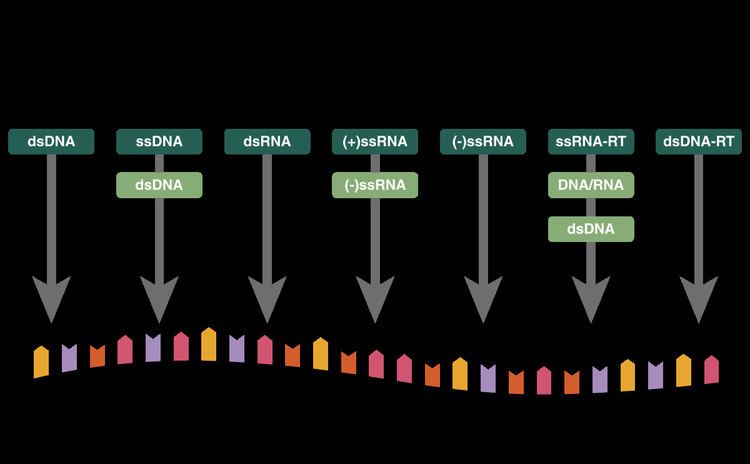 | ||
The Baltimore classification, developed by David Baltimore, is a virus classification system that groups viruses into families, depending on their type of genome (DNA, RNA, single-stranded (ss), double-stranded (ds), etc..) and their method of replication.
Contents
- Classifications
- Group I Double stranded DNA viruses
- Group II Single stranded DNA viruses
- Group III Double stranded RNA viruses
- Group IV V Single stranded RNA viruses
- Group IV Single stranded RNA viruses Positive sense
- Group V Single stranded RNA viruses Negative sense
- Group VI Positive sense single stranded RNA viruses that replicate through a DNA intermediate
- Group VII Double stranded DNA viruses that replicate through a single stranded RNA intermediate
- References
Classifications
Classifying viruses according to their genome means that those in a given category will all behave in much the same way, which offers some indication of how to proceed with further research. In short:
Group I: Double-stranded DNA viruses
These types of viruses must enter the host nucleus before they are able to replicate. Furthermore, these viruses require host cell polymerases to replicate the viral genome and, hence, are highly dependent on the cell cycle. Proper infection and production of progeny requires that the cell be in replication, as it is during replication that the cell's polymerases are active. The virus may induce the cell to forcefully undergo cell division, which may lead to transformation of the cell and, ultimately, cancer. Examples include Herpesviridae, Adenoviridae, and Papovaviridae.
There is only one well-studied example in which a class 1 virus is not replicating within the nucleus: the Poxvirus family, a highly pathogenic virus that infects vertebrates and includes the smallpox virus.
The mRNA is transcribed in the normal way from viral DNA using the host transcriptase enzymes, into two types of mRNA's: 1) early mRNA, transcribed prior to the synthesis of viral DNA, and 2) late mRNA, transcribed from progeny DNA.
Group II: Single-stranded DNA viruses
Viruses in this category include the Anelloviridae, Circoviridae, and Parvoviridae (which infect vertebrates), the Geminiviridae and Nanoviridae (which infect plants), and the Microviridae (which infect prokaryotes). Most of them have circular genomes (the parvoviruses are the only known exception). Eukaryote-infecting viruses replicate mostly within the nucleus - usually via a rolling circle mechanism, forming double-stranded DNA intermediate in the process. A prevalent but asymptomatic human Anellovirus, called Transfusion Transmitted Virus (TTV), is included within this classification.
Group III: Double-stranded RNA viruses
As with most RNA viruses, this class replicates in the "Core" capsid that is in cytoplasm, not having to use the host replication polymerases to as much a degree as DNA viruses. This family is also not as well-studied as the rest and includes 2 major families, the Reoviridae and Birnaviridae. Replication is monocistronic and includes individual, segmented genomes, meaning that each of the genes codes for only one protein, unlike other viruses that exhibit more complex translation.
Group IV & V: Single-stranded RNA viruses
The ssRNA viruses belong to Class IV or V of the Baltimore classification. They could be grouped into positive sense or negative sense according to the sense of polarity of RNA. The single stranded RNA is the common feature of these viruses. The replication of viruses happens in the cytoplasm or nucleus (for segmented class V viruses). Class IV and V ssRNA viruses do not depend as heavily as DNA viruses on the cell cycle.
Group IV: Single-stranded RNA viruses - Positive-sense
The positive-sense RNA viruses and indeed all RNA defined as positive-sense can be directly accessed by host ribosomes to immediately form proteins. These can be divided into two groups, both of which reproduce in the cytoplasm:
Examples of this class include the families Astroviridae, Caliciviridae, Coronaviridae, Flaviviridae, Picornaviridae, Arteriviridae, and Togaviridae.
Group V: Single-stranded RNA viruses - Negative-sense
The negative-sense RNA viruses and indeed all genes defined as negative-sense cannot be directly accessed by host ribosomes to immediately form proteins. Instead, they must be transcribed by viral polymerases into a "readable" form, which is the positive-sense reciprocal. These can also be divided into two groups:
Examples in this class include the families Arenaviridae, Orthomyxoviridae, Paramyxoviridae, Bunyaviridae, Filoviridae, and Rhabdoviridae (the latter of which includes the rabies virus).
Group VI: Positive-sense single-stranded RNA viruses that replicate through a DNA intermediate
A well-studied family of this class of viruses include the retroviruses. One defining feature is the use of reverse transcriptase to convert the positive-sense RNA into DNA. Instead of using the RNA for templates of proteins, they use DNA to create the templates, which is spliced into the host genome using integrase. Replication can then commence with the help of the host cell's polymerases.
Group VII: Double-stranded DNA viruses that replicate through a single-stranded RNA intermediate
This small group of viruses, exemplified by the Hepatitis B virus (which is in the Hepadnaviridae family), have a double-stranded, gapped genome that is subsequently filled in to form a covalently closed circle (cccDNA) that serves as a template for production of viral mRNAs and a subgenomic RNA. The pregenome RNA serves as template for the viral reverse transcriptase for production of the DNA genome.
